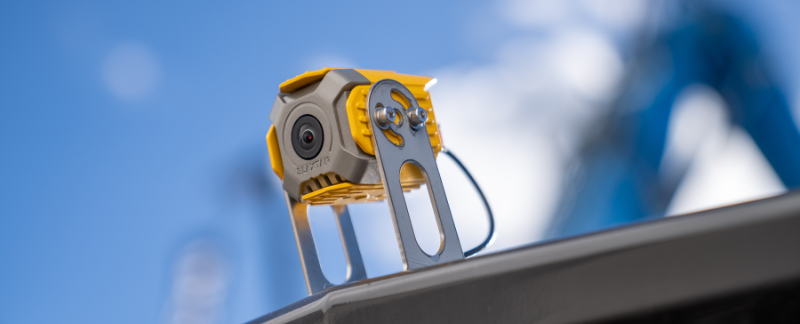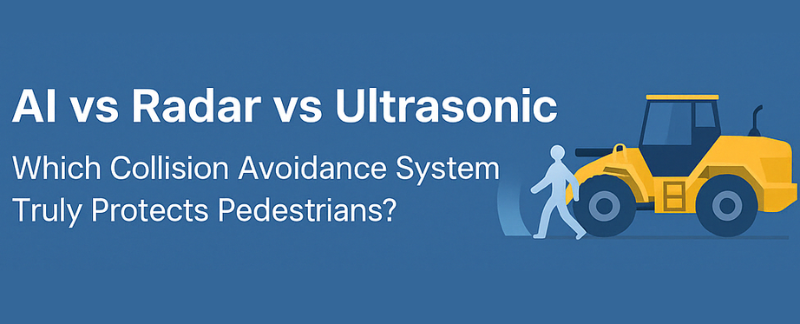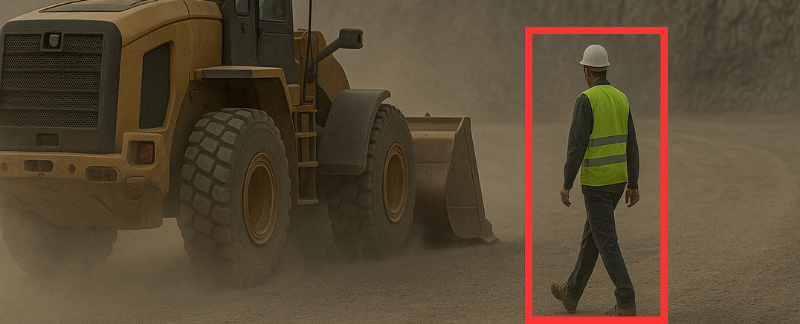Which Collision Avoidance System Truly Protects Pedestrians?
In high-risk industrial environments—like warehouses, quarries, construction sites, and mines—the safety of pedestrians working around forklifts and heavy machinery is a top priority. Industrial collision avoidance systems are designed to detect obstacles and prevent accidents, but not all technologies offer the same level of protection.
From traditional radar and ultrasonic sensors to cutting-edge AI-powered vision systems, the differences can be critical. In this article, we’ll break down how each technology works, compare their effectiveness, and reveal which system truly offers the smartest, most reliable protection for your team.
Understanding Collision Avoidance in Industrial Environments
In industrial operations—be it in mining, logistics, construction, or quarrying—the interaction between forklifts or heavy machinery and human workers presents constant risk. Collision avoidance systems for industrial vehicles are designed to mitigate these risks by detecting obstacles, especially pedestrians, and alerting operators in real-time.
The three main technologies available on the market—radar, ultrasonic, and AI-based camera systems—offer different approaches and capabilities. This article compares their strengths and weaknesses to help safety managers and operational leaders reduce workplace accidents by choosing the most effective solution for their environment.

Radar-Based Collision Avoidance: Strengths and Weaknesses
Radar systems detect objects by emitting radio waves and measuring the time it takes for them to bounce back. These are common in vehicle automation and some industrial applications.
Advantages:
- Performs well in poor visibility conditions such as dust, fog, or rain
- Offers long detection ranges, ideal for larger vehicles or open outdoor areas
- Robust and resilient in harsh industrial environments
Limitations:
- Can’t differentiate between a pedestrian and a static/inanimate object (e.g., a pole, a wall)
- High risk of false alarms or missed detections in cluttered environments
- Blind zones can exist depending on the sensor installation and angles
- Often needs pairing with other systems for full coverage
Radar systems are robust but fundamentally lack contextual understanding. In high-density pedestrian areas or environments where quick decisions are critical, this can become a major limitation.
Ultrasonic Sensors: Affordable but Limited
Ultrasonic systems operate by emitting high-frequency sound waves and measuring their reflections to detect nearby obstacles. They’re often installed on forklifts or automated guided vehicles (AGVs).
Advantages:
- Cost-effective and easy to install
- Useful in tight, indoor spaces
- Effective for close-range detection at low speeds
Limitations:
- Very limited detection range (usually under 2 meters)
- High rate of false positives, especially with soft materials or angled surfaces
- Unable to identify pedestrian movement or distinguish humans from objects
- Not suitable for rugged environments like mining or outdoor construction
While attractive for budget-conscious operations, ultrasonic sensors provide basic obstacle detection but offer no real intelligence or adaptability. Their use is best restricted to low-risk zones.
AI-Powered Vision Systems: Intelligent Detection with Real-Time Alerts
AI-based vision systems represent a new generation of industrial collision avoidance system. These use cameras and deep learning algorithms to recognize and detect pedestrians and differentiate them from other obstacles, even in complex environments and situations. This real-time analysis enables immediate and accurate operator alerts.
Advantages:
- Specifically trained to recognize human beings, even if partially hidden or crouching
- Drastically reduces false alarms by distinguishing between a person and an object
- Adaptable to dynamic, cluttered, complex environments and high-traffic areas like warehouses, quarries or mines
- Real-time alerts enable instant operator reactions
- Integrated connectivity allows for valuable data collection, reporting, and proactive risk management
Blaxtair’s embedded AI systems are ruggedized for off-road and industrial environments and comply with international safety standards, making them ideal for high-risk zones.
Unlike radar or ultrasonic, AI vision brings context and intelligence to detection. This allows operators to make the right decision at the right time, preventing serious accidents.
Side-by-Side Comparison: Radar vs Ultrasonic vs AI

| Feature | Radar | Ultrasonic | AI Vision (Blaxtair) |
|---|---|---|---|
| Human Detection | ❌No | ❌No | ✅Yes |
| False Alarm Rate | Medium | High | ✅Low |
| Detection Range | ✅Long | ❌Short | Medium-Long |
| Works in dusty/foggy areas | ✅Yes | ❌No | ✅Yes |
| Differentiates objects | ❌No | ❌No | ✅Yes |
| Real-time alerts | ❌Limited | ❌Limited | ✅Yes |
| Smart data logging | ❌No | ❌No | ✅Yes |
| Compliance support | ❌Partial | ❌No | ✅Yes |
This comparison clearly shows how AI-based systems outperform traditional technologies in all critical categories, particularly for environments where pedestrian safety is non-negotiable.
How to Choose the Right System for Your Industry
When radar makes sense:
- Autonomous vehicle use
- Low pedestrian traffic environments
- Long-range outdoor detection (as secondary system)
When ultrasonic fits:
- Small indoor operations with limited space and low-speed forklifts
- Budget-sensitive operations with basic safety needs
- Basic obstacle detection in simple layouts
- Applications where human presence is rare or controlled
When AI-based vision is ideal:
- Environments with frequent pedestrian-vehicle interactions
- Complex, dynamic layouts such as warehouses, quarries, mining sites
- Environments needing precise human detection and risk management
- Companies focused on safety compliance, data tracking, and long-term safety KPIs
- Organizations looking for scalable solutions compatible with Industry 4.0 strategies
The choice ultimately depends on your risk profile, operating environment, and regulatory landscape—but for high-risk zones with human presence, AI should be the standard.
Real-World Impact: Why Leaders Choose Blaxtair
Blaxtair is used by global leaders in construction, industry, and mining, including Vinci, Colas, ArcelorMittal and Forvia—testament to its proven field performance. Blaxtair’s AI-powered vision systems have already demonstrated their worth across various industries:
- When the Cloud-based IoT solution “Blaxtair Connect” is in operation, it reduces the risk of accidents between machines and pedestrians upstream by 3 (real result observed on the first sites of use).
- In open-pit mining and quarrying operations, Blaxtair continues to provide accurate detection despite dusty conditions where radar and ultrasonic systems consistently fail.
These real-world results underline the system’s ability to improve both safety outcomes and operational performance.
Final Thoughts: AI Is the Future of Industrial Safety
While radar and ultrasonic systems have their place, they fall short when it comes to truly protecting pedestrians in complex environments. AI-powered pedestrian detection systems like Blaxtair offer the intelligence, precision, and adaptability that modern high-risk environments demand.
Investing in a smart, AI-driven industrial collision avoidance system is more than a safety measure, it’s a commitment to operational excellence, workforce protection, and future-proof compliance.
Book a live demo of Blaxtair’s AI detection system today and see how it can help your business reduce risk, prevent downtime, and protect your most valuable asset—your people.

